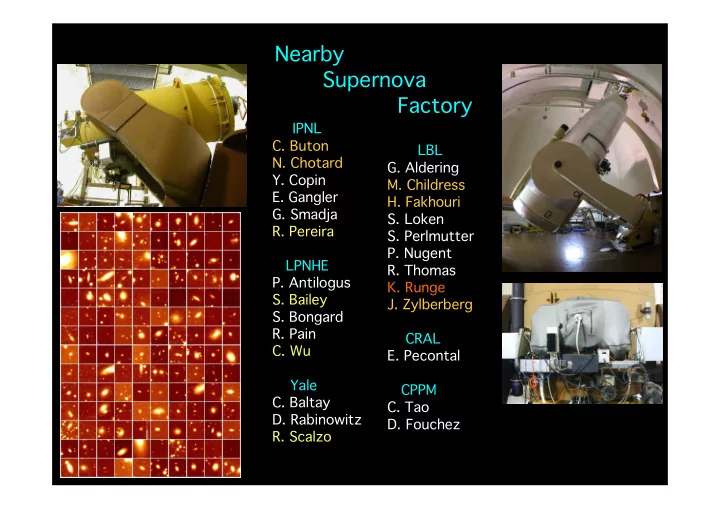

Nearby Supernova Factory IPNL C. Buton LBL N. Chotard G. Aldering Y. Copin M. Childress E. Gangler H. Fakhouri G. Smadja S. Loken R. Pereira S. Perlmutter P. Nugent LPNHE R. Thomas P. Antilogus K. Runge S. Bailey J. Zylberberg S. Bongard R. Pain CRAL C. Wu E. Pecontal Yale CPPM C. Baltay C. Tao D. Rabinowitz D. Fouchez R. Scalzo
A New Paradigm • Search at low redshift just like at high redshift • boost discovery rate • wide-field, impartial to presence of an associated galaxy • find better analogs to high-redshift environment • Fully integrate photometry and spectroscopy • for photometry: • Eliminate K-corrections and S-corrections • Tackle dust extinction using more colors • Eliminate atmospheric dispersion degeneracies • for spectroscopy: • Spectroscopy for more SNe • Time series of spectra for each SN • Properly subtract host galaxy light • Eliminate effects of slit losses and atmospheric dispersion
Getting to the Physics with Spectroscopy Luminosity Indicators Abundance Tomography Kinematics
Nearby Supernova Factory Search + + + = Oschin Schmidt HPWREN NERSC QUEST Camera
SNe over 2 π of the Sky More than 1000 SNe in ~28 months of searching during 2005-2008
SNe over 2 π of the Sky 624 SNe w/ spectroscopic types - mostly from the SuperNova Integral Field Spectrograph UH88 SNIFS 396 SNfactory & 50 IAUC SNe Ia
We faced fire and brimstone to get the data! Mag 6.7 earthquake hits Mauna Kea Fire closes Fire sweeps antenna site at North Peak Palomar Observatory
Type Ia Redshift Distributions SNfactory
Library of Spectral Time Series
Now Several Paths to SN Hubble Diagram Stretch-Color R (SiSS)-Color σ = 0.156 R (642/443) nMAD = 0.153 σ = 0.139 nMAD = 0.140 σ = 0.125 nMAD = 0.110 Bailey Bailey et et al, al, 2009 2009
R 642/443 Handles Difficult Cases SNF20080720-001
Stretch-Color Hubble Diagram Note - Note - offset offset still still blinded! blinded! 45 Hamuy et al. (1996) Krisciunas et al. (2005) 40 Riess et al. (1996) Jha et al. (2006) Kowalski et al. (2008) Hicken et al. (2009) Supernova Factory LA Set Holtzman et al. (2009) Riess et al. (1998) + HZT Perlmutter et al. (1999) Tonry et al. (2003) Barris et al. (2003) Amanullah et al. (2008) 35 Amanullah et al. (2009) Knop et al. (2003) Riess et al. (2006) Astier et al. (2006) Miknaitis et al. (2007) 0.0 1.0 2.0 Redshift courtesy D. Rubin
Have We Seen the Double-Degenerates? z = 0.123
Environmental Clues and Constraints Mike Childress PhD thesis Galaxy Metallicity Galaxy Luminosity
A/D converter module Photdiode preamp USB extender Integrator electronics Calibrated photodiode Beam launch optics Optical Fiber Optical fiber Tunable laser (Opotek) Technique: • Illuminate flat field screen with monochromatic laser light from a tunable Second harmonic (532 nm) generator laser, and take a spectral image at each λ . • Deliver a fixed “dose” of light to the system, Mixer (to 355 nm) as measured by a NIST calibrated photodiode. • Measuring the flatfield flux relative to that 1.06 micron Nd:YAG pulsed laser seen by the photodiode allows the measurement of the total system throughput, Tunable downconverer in situ, relative to the well-characterized diode. Courtesy C. Stubbs
Work for the Coming Year • SNIFS • Complete final references for 2005-2008 SNe • Follow-up of SNe Ia targeted by HST/STIS • Supplement current sample with other interesting SNe • Development of absolute color calibration system • Cosmology analysis • Finalize flux calibration • Complete host galaxy redshifts • Finalize host subtraction pipeline • Spectral analysis • Develop new/improved spectral luminosity indicators • Abundance tomography • Spectral temporal-luminosity model, F( λ ,t,s)
Summary • Several fundamentally different standardization methods have been demonstrated to work well using spectrophotometric data. • New methods using spectrophotometry are showing significant improvement over imaging based methods. • Type Ia population dominated by SNe standardizable to 6%. • Highly-extincted SNe Ia can be standardized at optical wavelengths – more examples needed to break intrinsic color - dust degeneracy • Oddball SNe Ia and those in low-luminosity hosts help probe progenitor properties. • Deeper understanding of SNe Ia for cosmology demands spectrophotometry
Recommend
More recommend